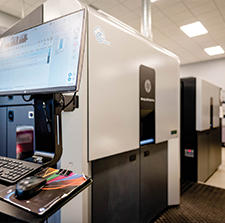5 Common Print Technologies Explained
November 30, 2022
Printing technology has come a long way since its inception. Today, several different printing technologies are used for various purposes. In this blog, we will discuss four popular print technologies: offset, gravure, flexo, and digital.
Offset Printing
Offset printing, also known as lithography, is a printing technique that involves transferring ink from a plate to a rubber blanket and then onto paper. The inked image is transferred onto the paper through a process called offsetting, hence the name “offset printing.”
Offset printing is a popular choice for label printing due to its ability to produce high-quality prints quickly and efficiently. It is also cost-effective for large print runs, making it ideal for mass production. Our offset presses exist at our La Crosse facilities. Inland produces many of its beer, consumer products, food, beverage, and water labels using offset printing.
Gravure Printing
Gravure printing, also known as rotogravure printing, is a technique that involves etching an image onto a metal cylinder. The cylinder is then coated with ink, and the inked image is transferred onto paper as it passes through a series of rollers. Gravure printing is best utilized on brands that rarely have significant graphics changes.
Gravure printing is a more economical choice for higher-volume printing jobs for labels. The high quality of the prints, co and the ability to print at high speeds gravure printing a popular choice for these types of projects. Our gravure press is housed at our La Crosse, WI headquarters. Inland produces much of our big beer and roll-fed IML on our gravure asset.
Flexographic Printing
Flexographic printing, also known as flexo printing, is a technique that uses flexible printing plates made of rubber or photopolymer. These plates are mounted onto cylinders, which are then used to transfer ink onto the substrate. Flexo printing can be used on just about any material substrate.
Flexo printing is used for a variety of projects including labels and packaging. Most commonly, Inland produces our pressure sensitive and shrink sleeve labels and flexible packaging roll stock utilizing flexo print technology.
Digital Printing
Digital printing is a technique that involves printing digital images directly onto paper or other substrates. Unlike offset, gravure, and flexo printing, which require the creation of printing plates, digital printing does not require any setup time.
Digital printing is ideal for short print runs, as well as for projects that require variable data printing. It is also possible to print on demand, making it a popular choice for businesses that need to print materials quickly and efficiently.
Each of these print technologies has its own strengths and weaknesses, and the choice of which technology to use will depend on the project’s specific needs. Offset printing is a good choice for large print runs, gravure printing is ideal for high-volume jobs, flexo printing is versatile and can print on a variety of surfaces, and digital printing is great for short print runs, variable printing and on-demand printing.
Inland recently invested in a new press that is a combination of both digital and flexo printing, our ABG-Durst hybrid press. The beauty of this press is that it takes the best attributes of digital and flexo print technologies and combines them into one. The digital engine utilizes digital inkjet, which varies from our digital press that utilizes toner inks. One of our favorite things about this press is that it can finish jobs inline, making the process much more efficient and streamlined.
All in all, there is a time and a place for each of these print technologies, and even better, at times, they can be used interchangeably. If you are looking to learn more about how Inland utilizes each of their print technologies, Let’s Talk.



